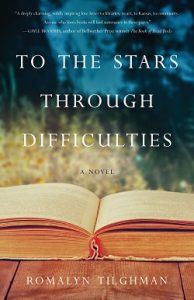To the Stars Through Difficulties
 I’ve loved fiction about women for as long as I can remember. I come by that love naturally. My mother had subscriptions to McCall’s and Redbook; my grandmother divided The Woman’s Home Companion into thirty segments to ensure there would be something to read every night during her otherwise somewhat dismal life as an early Oklahoma settler.
I’ve loved fiction about women for as long as I can remember. I come by that love naturally. My mother had subscriptions to McCall’s and Redbook; my grandmother divided The Woman’s Home Companion into thirty segments to ensure there would be something to read every night during her otherwise somewhat dismal life as an early Oklahoma settler.
When it came time to write a thesis in pursuit of a M.S. in Journalism, I chose the topic of women’s magazine fiction. Betty Friedan, in The Feminine Mystique, had noted heroines in those magazines had changed in aspiration and occupation during the war years. I wanted to examine what had happened since. Friedan had observed the women in those stories went to work, found their own interests and self-esteem, while their husbands/boyfriends were off fighting.
I assumed I’d find similar changes in magazines in the years after, when Gloria Steinem and women’s liberation were taking hold. In fact, my hypothesis was proven wrong. While heroines had high-powered careers as lawyers and doctors, their dreams had not changed significantly. Happy endings still revolved around finding true love.
 My thesis came to mind several decades later as I struggled with my first attempts at writing fiction. I realized how ingrained were the classic storylines of finding Mr. Right. How else to end a tale if not with the promise of a walk down the aisle? In real life, I’d found love through friends and family to be more substantial and meaningful than love of a single man, but it was hard to put those lessons into fictional form, especially in creating a satisfying ending.
My thesis came to mind several decades later as I struggled with my first attempts at writing fiction. I realized how ingrained were the classic storylines of finding Mr. Right. How else to end a tale if not with the promise of a walk down the aisle? In real life, I’d found love through friends and family to be more substantial and meaningful than love of a single man, but it was hard to put those lessons into fictional form, especially in creating a satisfying ending.
As much as I’d preached to my younger friends that there is no such thing as a happy ending, and that life is best measured in minutes along the journey, I found it challenging to put other motivations on the page.
To complicate the fact, I was writing about Kansans. As a native myself, I can say it: we are not a dramatic lot. We don’t scream our ambitions nor engage in much “navel-gazing.” We have a tendency to put one foot in front of another to get a job done. We’re better at facing whatever the Universe deals us than in articulating our own goals or wishing out loud. As well as this serves us in real life, it doesn’t necessarily make for a compelling read.
As I struggled with my writing, I attended several workshops. The Wizard of Oz was inevitably cited for exemplary structure. I bristled, as Kansans often do, worried the cliché defined our culture. Yet every day I saw references to this classic. If anyone had the right to appropriate its lessons, didn’t I, in a story about Kansas?
In the end, my characters are motivated by the universal aspirations of the scarecrow, the tinman, and the lion. One seeks love, one sees wisdom, one seeks courage, and all find they had them all along. They determine these are not stereotypes but archetypes. And they use these gifts to actively create a thriving community, to ensure “there’s no place like home.” Making a home means more than finding a soulmate, more than raising children. Making a home means changing the world. It’s as simple, and complicated, as that.
—
Romalyn Tilghman was the Executive Director of the Association of Community Arts Councils of Kansas and worked for the National Endowment for the Arts as Regional Representative. For more than twenty years, she has worked as a freelance consultant in the arts. She has served on the boards of Americans for the Arts, Association of California Symphony Orchestras, and Western Arts Alliance, as well as on numerous national panels. She lives in Long Beach, California. To the Stars through Difficulties is her first novel. Find her online on her website or FaceBook.
About TO THE STARS THROUGH DIFFICULTIES
Andrew Carnegie funded fifty-nine public libraries in Kansas in the early 20th century―but it was frontier women who organized waffle suppers, minstrel shows, and women’s baseball games to buy books to fill them. Now, a century later, Angelina returns to her father’s hometown of New Hope to complete her dissertation on the Carnegie libraries, just as Traci and Gayle arrive in town―Traci as an artist-in-residence at the renovated Carnegie Arts Center and Gayle as a refugee whose neighboring town, Prairie Hill, has just been destroyed by a tornado.
The discovery of an old journal inspires the women to create a library and arts center as the first act of rebuilding Prairie Hill after the tornado. As they work together to raise money for the center, Traci reveals her enormous heart, Angelina discovers that problem-solving is more valuable than her PhD, and Gayle demonstrates that courage is not about waiting out a storm but building a future. Full of Kansas history―from pioneer homesteaders to Carrie Nation to orphan trains―To the Stars through Difficulties is a contemporary story of women changing their world, and finding their own voices, powers, and self-esteem in the process.
Category: On Writing


























I was in the middle of an email to you, and wanted to look something up on the web. Because I googled you yesterday, and also because Google has a new format on the search page whereby they show a list of your recent past searches, there you were! I hadn’t taken the time to read very much of it, but took the occasion to do so just now.
Yes, yes, yes!!! You go, girl! New open guidelines for defining human relations must become a reality.
Now, back to the email.